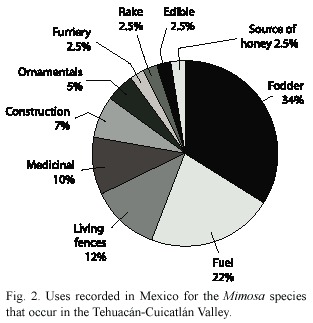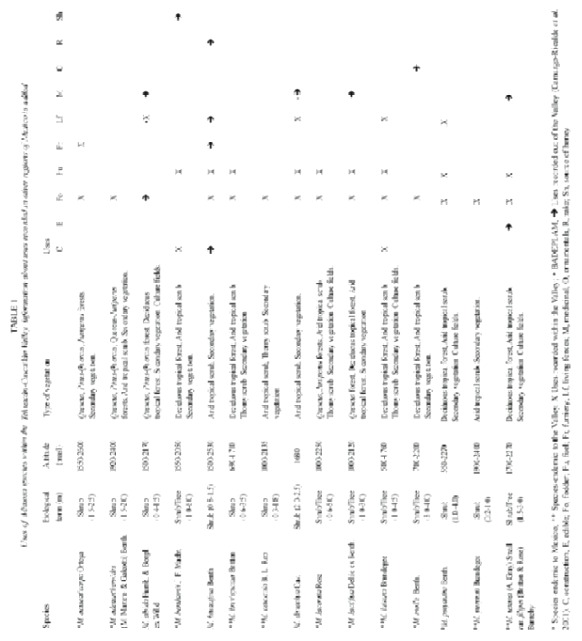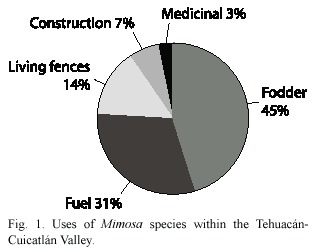Services on Demand
Journal
Article
Indicators
-
 Cited by SciELO
Cited by SciELO -
 Access statistics
Access statistics
Related links
-
 Similars in
SciELO
Similars in
SciELO  uBio
uBio
Share
Revista de Biología Tropical
On-line version ISSN 0034-7744Print version ISSN 0034-7744
Rev. biol. trop vol.52 n.4 San José Dec. 2004
Use and management of Mimosa species in the Tehuacán-Cuicatlán Valley, a tropical semi-arid region in Mexico (Fabaceae-Mimosoideae)
S.L.Camargo-Ricalde1,2 &S.S.Dhillion2,3
1 Universidad Autónoma Metropolitana-Iztapalapa,Div.Ciencias Biológicas y de la Salud, Dpto.Biología,Apdo. Postal 55-535,09340,México D.F.Fax:+525558044688;slcr@xanum.uam.mx
2 Agricultural University of Norway,Dept.Ecology and Natural Resource Management,P.O.Box 5003,N-1432,Ås, Norway.Fax:+4764948502
3 University of Oslo,Centre for Development and the Environment,SUM-UiO,Sognsveien 68,P.O.Box 1116 Blindern,N-0317,Oslo,Norway.
Received 10-VIII-2003. Corrected 14-VI-2004. Accepted 16-VIII-2004.
Abstract:We report on the use of 15 Mimosa species within the Tehucán-Cuicatlán Valley,south-central Mexico.Seven of these species are endemic to Mexico,and four species and one variety are endemic to the Valley.We reviewed historical,ethnobotanical and floristic manuscripts,and conducted field studies.Several herbaria were consulted,as well as the BADEPLAM data base.Field work in the Valley has been done from 1994 to date.Most of the Mimosa species occur in the arid tropical scrub and the tropical deciduous forest,which are considered the most endangered vegetation types of the Valley.Our findings show that Mimosa species are used as fodder (45%),fuel (31%),living fences (14%)and construction material (7%).Only one species is used as medicine.Mimosa species are "multipurpose "shrubs/trees of the agrosilvopastoral system of this region.Rev. Biol.Trop.52(4):845-851.Epub 2005 Jun 24.
Key words:Agrosilvopastoral systems,biosphere reserve,conservation,Mexico,natural resources, semiarid region.
Mexican deserts possess a high plant and animal diversity,and are considered the center of origin and evolution of many taxa (Rzedowski 1962,Challenger 1998).Since pre-Columbian times they have also been home to and supported the livelihood of different ethnic and local communities (Rzedowski 1978, Valiente-Banuet 1990).
The Tehuacán-Cuicatlán Valley (part of it a Biosphere Reserve since 1998)is a semiarid region located in South-central Mexico (17 °20 -18 °53 N,and 96 °55 -97 °44 W),with a surface area of ca.10 000 km2 ,within the states of Puebla and Oaxaca.Plant diversity is high,with ca.3 000 species,of which 30% are estimated to be endemic (Smith 1965, Villaseñor et al.1990,Dávila et al.1993).The Fabaceae family comprises 10%of the plant species of the zone,72 legume genera (288 species)have been reported (Dávila et al.1993). Fifteen of the legume species recorded belong to genus Mimosa L.;seven of these species are endemic to Mexico,and other four species and one variety are endemic to the Valley (Martínez-Bernal and Grether 2003).
On the other hand,in addition to the most customary production systems developed within the Valley (irrigated and shifting rainfed agriculture,and extensive goat grazing), local communities commonly make use of the available natural resources (Zavala-Hurtado and Hernández-Cárdenas 1998), although very little is known concerning the use of these resources.General field observations have pointed to a major use of Mimosa species as part of the traditional agrosilvopastoral systems within the Tehuacán-Cuicatlán Valley.The aim of this study is to report on and analyze the different uses of Mimosa species within the Valley,and to discuss the importance of the genus as a natural resource for the region and as part of the conservation and management strategies planned within the Valley and the Reserve Management Program.
Material and methods
Field work included surveys,plant collections and market visit in the Valley from 1994 to date;voucher specimens are deposited at the Herbario Metropolitano (UAMIZ) of the Universidad Autónoma Metropolitana-Iztapalapa.Other sources of information included herbaria consultations (CODAGEM, ENCB,IEB,IMSSM,MEXU and UAMIZ). Because most of the information about the uses of Mimosa species is disseminate,the revision of historic documents,and ethnobotanical, floristic and ecological studies was done.The Mexican Plants Ethnobotanical Information Data Base (Banco de Información Etnobotánica de Plantas Mexicanas,BADEPLAM)of the Jardín Botánico,Instituto de Biología, Universidad Nacional Autónoma de México, was also consulted.
Results
Although several Mimosoideae species were used since pre-Columbian times (e.g. Acacia spp.,Calliandra spp.,Enterolobium spp.,Leucaena spp.,Prosopis spp.),there was not enough evidence to associate any Mimosa species as one of the species mentioned in the historical reviews (e.g.Annals of the National Medical Institute 1894-1912,Sahagún 1548, Hernández 1570-1576,Clavijero 1787), except in the manuscript of De la Cruz (1552),which mentions a plant called "huihuitzyocochizxihuitl ",positively identified as Mimosa sp.and whose leaves are used to heal insomnia.Recent ethnobotanical, floristic and ecological studies (e.g.Martínez 1969,Del Amo 1979,Mendieta and del Amo 1981,Cedillo-Portugal 1990, Martínez-Alfaro et al.1995,Soto-Núñez and Sousa 1995,Camargo-Ricalde 2000)register some useful Mimosa species;and Camargo-Ricalde et al.(2001)present a preliminary list of the useful Mexican Mimosa species.
However,only two studies report the use of Mimosa species within the Tehuacán-Cuicatlán Valley.Casas et al.(2001)recorded 104 useful legume species,including M. albida and M.luisana ,and Martínez-Bernal and Grether (2003)reported the use of four Mimosa species (M.albida ,M.calcicola ,M. luisana and M.polyantha ).
Field work and herbaria revision point out that the 15 Mimosa species found in the Valley are used by local people (Table 1).Most of the species occur in the "matorral xerófilo "(arid tropical scrub),the "selva baja caducifolia " (deciduous tropical forest)and the "matorral espinoso "(thorny scrub);just a few species can establish in the Quercus ,Pinus-Quercus and Juniperus forests;though all of them are also found in secondary vegetation,along roads and in resting culture fields.
Nine species are shrubs (60%)and the other six are either shrubs or trees (40%);these species are mostly used as fodder for goats and as a source of wood for fuel and construction mainly of fences and animal shelters (Table 1,Fig.1).Four species (M.aculeaticarpa ,M. dystachia ,M.luisana and M.polyantha )are used as living fences protecting corn fields. The leaves,branches and roots of M.albida are used in traditional medicine to heal stomach diseases, insomnia and body pain.In addition, these plants have not been found in any market of the zone as a "product ",hence people do not get any economic benefits directly from them.
In different parts of Mexico,other uses have been recorded for seven species found in the Valley (Camargo-Ricalde et al.2001) (Table 1,Fig.2).M.texana is consumed by humans in the state of Guanajuato (no specification of the edible part);M.biuncifera is used in the furriery industry and as a farm tool (Camacho-Morfín et al.1998);M.albida and M.mollis as ornamentals,and M.benthamii as a source of honey for bees.In the N-NW of the country the bark of M.dystachia is used for healing skin wounds and to harden teeth gums;M.lacerata for healing fever eruptions in the mouth (not more data specified),and in Guanajuato M.texana is used for healing headaches,fever,rheumatism and fatigue (no information found about which parts of the plant are used)(Camargo-Ricalde et al.2001).

It is important to note that Mimosa species contain high levels of tannins in all shoot parts,substances usually regarded as unpalatable to animal and human taste.However,tannins are also astringents favoring the healing of skin wounds.
For all the uses reported for the 15 species studied,60%are found within the Valley and the other 40%are recorded for other regions within Mexico.
Discussion
The 15 useful Mimosa species reported in this study represent ca.50%of all the useful Mimosa species found in Mexico.For the first time,the use of M.adenantheroides , M.brevispicata and M.purpusii is reported, increasing the number of useful Mimosa species of Mexico from 32 (Camargo-Ricalde et al.2001)to 35.
Most of the Mimosa species occur in the "matorral xerófilo "(arid tropical scrub)and the "selva baja caducifolia "(tropical deciduous forest),which are considered the most endangered vegetation types of the Valley (Zavala-Hurtado and Hernández-Cárdenas 1998).Within these vegetation types,human activities mainly focus on rainfed agriculture and extensive goat grazing;hence,there is a high need to ecologically restore the area and,at the same time,allow people to continue their traditional agricultural activities.In the case of developing countries, management programs ought to focus on native species that are important in terms of diversity conservation,economic and cultural value for local people. Mimosa species fit these requirements as "multipurpose "plants.For instance, most of the species are already used as fodder, fuel production and living fences;they are also used for controlling soil erosion and for the regeneration of soil nutrients in abandoned culture and grazing fields.The presence of Mimosa species contribute to ameliorate soil nutrient conditions as well as other environmental factors (e.g.lower temperatures, higher humidity,shadow producers)under their canopy (Camargo-Ricalde et al .2002) creating what it is called "resource islands " (Reynolds et al.1999).
The use and management of "multipurpose "shrubs and trees (e.g.Miehe 1986,Cony 1995)in agrosilvopastoral systems have shown good results in terms of soil and vegetation restoration in diverse drylands of Central America (e.g.Budowski 1993,Kass et al.1993)and other regions of the world (e.g.Gutteridge and Shelton 1993,Thomson et al.1994,Pandey et al.2000).For Latin America,five Mimosa species have partially been studied:M.bahamensis Benth (Grether and Camargo-Ricalde 1993), M. biuncifera and M.monancistra Benth.(Grether 1982),M.scabrella Benth.(Kass and Somarriba 1999, Somarriba and Kass 2001),and M.tenuiflora (Willd.)Poir.(Nolasco and Landaverde 1988, Sampaio et al.1993,Camargo-Ricalde and Grether 1998,Camargo-Ricalde 2000). Although more research is needed to characterize the fallow systems developed in the Valley, the use of Mimosa species is a real option for management strategies through the improvement of agrosilvopastoral systems within the Tehuacán-Cuicatlán Valley.Hence,our results point to the use of Mimosa species as an option for restoration processes in the semiarid Valley of Tehuacán-Cuicatlán.
Camargo-Ricalde et al.(2001)reported that 15%of all useful Mimosa species in the country are used in traditional medicine.The chemical compounds present in these plants require investigation.The bark (rich in tannins and other compounds)of M.tenuiflora has been used in the cosmetic industry (with two patents already recorded)within Mexico and other countries as France,Italy and Japan (Camargo-Ricalde 2000).
Though,Mimosa is the genus with the highest number of species (100-110),of which 60% are endemic,of all the Mexican Mimosoideae (Grether et al.1996,Sousa and Delgado 1993), there is a huge gap of biological,ecological and biochemical information which needs to be filled to understand the potential of this genus as a natural resource for Mexico.
Acknowledgments
We thank Rosaura Grether,Mariel Aguilar Støen and Gaseitsiwe Masunga for their advice and Javier Caballero and Laura Cortés for facilitating the use of the BADEPLAM database.This work was supported in part by the Consejo Nacional de Ciencia y Tecnología (CONAC y T,grant 112386 to S.L.C.-R.)and the Universidad Autónoma Metropolitana.The research is linked to that of the Management of Biodiversity Group and NTFP research at SUM-University of Oslo and the Agricultural University of Norway led by S.S.Dhillion.
Resumen
En este trabajo se informa el uso de 15 especies del género Mimosa dentro de la Reserva de la Biósfera del Valle de Tehuacán-Cuicatlán,en la región centro-sur de México.De las 15 especies de Mimosa estudiadas,siete de ellas son endémicas de México y cuatro especies y una variedad son endémicas del Valle.Se revisaron manuscritos y documentos históricos,etnobotánicos y florísticos,y se llevó a cabo trabajo de campo.Se consultaron varios herbarios,así como la base de datos BADEPLAM.El trabajo de campo en el Valle se está realizando desde 1994 hasta la fecha.La mayoría de las especies de Mimosa se establecen en el matorral xerófilo,el cual está considerado como el
tipo de vegetación que está más en peligro de todos los que se encuentran en la Reserva.Los resultados muestran que la mayoría de las especies de Mimosa se usan como forraje (45%)y como combustible (31%),así como en la formación de cercas vivas (14%)y como material para construcción (7%);mientras que sólo una especie presenta un uso medicinal.Las especies de Mimosa son arbustos y/o árboles "multipropósito "en los sistemas agrosilvopastoriles practicados en el Valle de Tehuacán-Cuicatlán.
Palabras clave :Sistema silvoagropastoril,reserva de la biosfera,conservación,México,recursos naturales, región semiárida.
References
Budowski,G.1993.The scope and potential of agroforestry in Central America.Agrof.Syst.23:121-131. [ Links ]
Camacho-Morfín,D.C.,C.Sandoval &A.Ayala.1998. Identificación de especies leñosas forrajeras en el Valle del Mezquital,Hidalgo,México.Abstract book. VII Congreso Latinoamericano de Botánica and XIV Congreso Mexicano de Botánica.México.57 p. [ Links ]
Camargo-Ricalde,S.L.&R.Grether.1998.Germinación, dispersión y establecimiento de plántulas de Mimosa tenuiflora (Leguminosae)en México.Rev.Biol Trop. 46:543-554. [ Links ]
Camargo-Ricalde,S.L.2000.Descripción,distribución, anatomía,coposición química y usos de Mimosa tenuiflora (Fabaceae-Mimosoideae)en México.Rev. Biol.Trop.48:939-954. [ Links ]
Camargo-Ricalde,S.L.,R.Grether,A.Martínez-Bernal,V. García-García &S.Barrios del Rosal. 2001.Especies útiles del género Mimosa (Fabaceae-Mimosoideae) en México.Bol.Soc.Bot México 68:33-44. [ Links ]
Camargo-Ricalde,S.L.,Dhillion,S.S.&Grether,R.2002. Community structure of endemic Mimosa species and environmental heterogeneity in a semi-arid Mexican valley.J.Veg.Sci.13:697-704. [ Links ]
Casas,A.,A.Valiente-Banuet,J.L.Viveros,J.Caballero,L. Cortés,P.Dávila,R.Lira & I. Rodríguez. 2001. Plant resources of the Tehuacán-Cuicatlán Valley,Mexico. Econ.Bot.55:129-166. [ Links ]
Cedillo-Portugal,E.1990.Las plantas útiles del Municipio de Tepoztlán,Morelos.Tesis de maestría,Facultad de Ciencias, UNAM,México,425 p. [ Links ]
Challenger,A.1998.Utilización y conservación de los ecosistemas terrestres de México. Pasado, presente y futuro. CONABIO,UNAM y Agrupación Sierra Madre,S.C.México,p.25-71. [ Links ]
Clavijero,F.J.1787.Historia antigua de Méjico.Diez libros sobre la tierra,animales y habitantes de Méjico. Yolva, México.439 p. [ Links ]
Cony,M.A.1995.Reforestación racional de zonas áridas y semiáridas con árboles de múltiples propósitos. Interciencia 20:249-253. [ Links ]
Dávila,P.,R.J.L.Villaseñor,L.R.Medina,R.A.Ramírez, T.A.Salinas,J.Sánchez-Ken &P.Tenorio.1993. Flora del Valle de Tehuacán-Cuicatlán.Listados Florísticos de México X.Inst.Biología,UNAM, México.195 p. [ Links ]
De la Cruz,M.1552.Libellus de Medicinalibus Indorum Herbis.Manuscrito,versión española.Instituto Mexicano del Seguro Social.México.385 p. [ Links ]
Del Amo,S.1979.Plantas medicinales del estado de Veracruz.Inst.Nacional de Investigaciones sobre Recursos Bióticos (INIREB),México.279 p. [ Links ]
Grether,R.1982.Aspectos ecológicos de M.biuncifera y M.monancistra en el noroeste del estado de Guanajuato. Bol. Soc. Bot.Mex.43:43-60. [ Links ]
Grether,R.&S.L.Camargo-Ricalde.1993.Mimosa bahamensis (Leguminosae)en la Península de Yucatán. Bol. Soc. Bot. Mex.53:55-72. [ Links ]
Grether,R.,S.L.Camargo-Ricalde &A.Martínez-Bernal. 1996.Especies del género Mimosa (Leguminosae)presentes en México. Bol.Soc.Bot.Mex.58:149-152. [ Links ]
Gutteridge,R.C.&H.M.Shelton.1993.The scope and potential of tree legumes in agroforestry. Agrof.Syst. 23:177-194. [ Links ]
Hernández,F.1570-1576.Historia de las plantas de la Nueva España.Tomo 2,p.560-561. [ Links ]
Kass,D.C.L.,C.Foletti,L.T.Szott,R.Landaverde &R. Nolasco.1993.Traditional fallow systems of the Americas. Agrof. Syst.23:207-218. [ Links ]
Kass,D.C.L.&E.Somarriba.1999.Traditional fallows in Latin America.Agrof.Syst.47:13-36. [ Links ]
Martínez,M.1969.Las plantas medicinales de México. Botas,México,656 p. [ Links ]
Martínez-Alfaro,M.A.,V.Evangelista,M.Mendoza,G. Morales,G.Toledo &A.Wong.1995.Catálogo de plantas útiles de la Sierra Norte de Puebla,México. Inst.Biología,UNAM,México.303 p. [ Links ]
Martínez-Bernal,A.&R.Grether.2003.Mimosa,p.100.In L.Kelly &R.Medina-Lemus (eds.).Flora del Valle de Tehuacán-Cuicatlán.Fascículo 33.Inst.Biología, UNAM,México. [ Links ]
Mendieta,R.M.&S.del Amo.1981.Plantas medicinales del estado de Yucatán.Inst.Nacional de Investigaciones sobre Recursos Bióticos (INIREB), México.428 p. [ Links ]
Miehe,S.1986.Acacia albida and other multiporpuse trees on the fur farmlands in the Jebel Marra highlands, Western Darfur,Sudan.Agrof.Syst.4:89-119. [ Links ]
Nolasco,R.&R.Landaverde.1988.Diagnóstico del sistema agroforestal tradicional maíz-maicillo-carbón negro (Mimosa tenuiflora ).Programa Marcala-Goascoran (Margoas).Secretaría de Recursos Naturales. Tegucigalpa,Honduras.25 p. [ Links ]
Pandey,C.B.,A.K.Singh &D.K.Sharma.2000.Soil properties under Acacia nilotica trees in a traditional agroforestry system in central India.Agrof.Syst.49: 53-61. [ Links ]
Reynolds,J.F.,R.A.Virginia,P.R.Kemp,A.G.de Soyza &D.C.Tremmel.1999.Impact of drought on desert shrubs:effects of seasonality and degree of resource islands development.Ecol.Monogr.69: 69-106. [ Links ]
Rzedowski,J.1962.Contribución a la fitogeografía florística e histórica de México.I.Algunas consideraciones acerca del elemento endémico en la flora mexicana. Bol.Soc.Bot.Mex.27:52-65. [ Links ]
Rzedowski,J.1978.Vegetación de México.Limusa, México.431 p. [ Links ]
Sahagún,F.B.1548.Códice Florentino.Vol.III.Libros Décimo y undécimo.Fo:97-114 y 139-178.Secretaría de Gobernación, México. [ Links ]
Sampaio,E.V.S.B.,I.H.Salcedo &J.B.Kauffman.1993. Effect of different fire severities on coppicing of Caatinga vegetation in Sierra Talhada,PE,Brazil. Biotropica 25:452-460. [ Links ]
Smith,C.E.1965.Flora Tehuacán Valley.Fieldiana Bot. 31:101-143. [ Links ]
Somarriba,E.&D.C.L.Kass.2001.Estimates of above-ground biomass and nutrient accumulation in Mimosa scabrella fallows in southern Brazil.Agrof. Syst.51:77-84. [ Links ]
Soto-Nuñez,J.C.&M.Sousa.1995.Plantas medicinales de la cuenca del Río Balsas. Inst. Biología,UNAM, México,198 p. [ Links ]
Sousa,M.&A.Delgado.1993.Mexican Leguminosae: phytogeography,endemism,and origins,p.459-511. In T.P.Ramamoorthy,R.Bye,A.Lot &J.Fa (eds.). Biological diversity of Mexico:origins and distribution. Oxford University. [ Links ]
Thomson,L.A.J.,J.W.Turnbull &B.R.Maslin.1994.The utilization of Australian species of Acacia ,with particular reference to those of the subtropical dry zone. J.Arid Environ.27:279-295. [ Links ]
Valiente-Banuet,A.1990.Los desiertos de México.Rev. Soc.Mex.Hist.Nat.41:83-84. [ Links ]
Villaseñor,J.L.,P.Dávila &F.Chiang.1990.Fitogeografía del Valle de Tehuacán-Cuicatlán. Bol. Soc. Bot. Mex. 50:135-149. [ Links ]
Zavala-Hurtado,J.A.&G.Hernández-Cárdenas.1998. Estudio de caracterización y diagnóstico del área propuesta como Reserva de la Biósfera Tehuacán-Cuicatlán.UNAM-Instituto Nacional de Ecología (SEMARNAP),México. [ Links ]
















